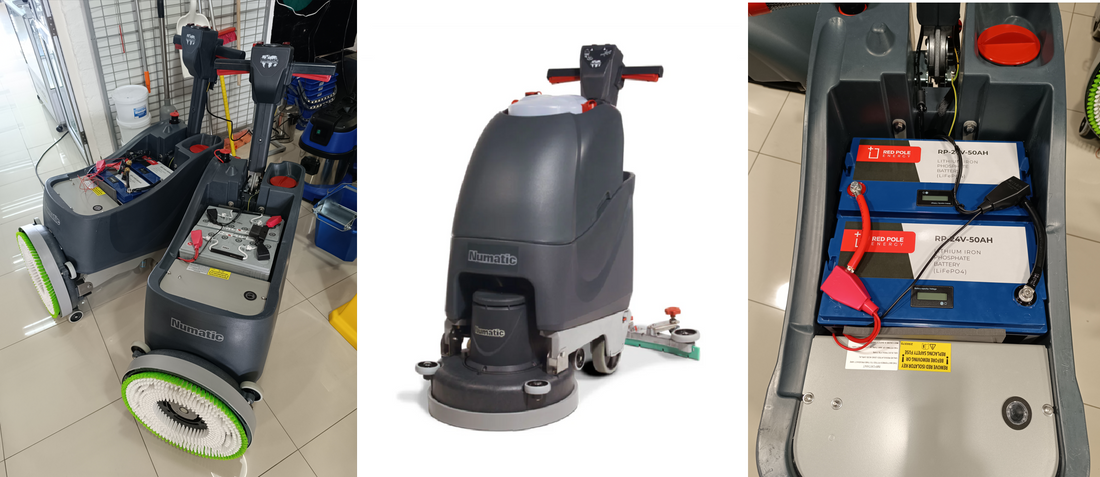
The Transition from Lead-Acid to Lithium Batteries in Industrial Applications
Share
The Transition from Lead-Acid to Lithium Batteries in Industrial Applications
As industries increasingly seek to enhance efficiency, reliability, and sustainability, the shift from traditional lead-acid batteries to lithium-ion alternatives has become a prominent trend. This transition is driven by the numerous advantages that lithium batteries offer over their lead-acid counterparts, particularly in sectors such as telecommunications, safety, security, mining, golfing, and industrial cleaning.

Advantages of Lithium Batteries
Lithium batteries present several key benefits that make them an attractive option for various industrial applications. These benefits not only enhance the operational efficiency of the equipment but also contribute to long-term cost savings and environmental sustainability.
- Extended Lifespan: One of the most significant advantages of lithium batteries is their longer lifespan. While lead-acid batteries typically require replacement after 500 to 1,000 cycles, lithium batteries can endure 3,000 to 5,000 cycles, depending on usage patterns and depth of discharge. This increased longevity results in a lower total cost of ownership, as equipment operators benefit from fewer replacements, reduced downtime, and less frequent maintenance.
- Rapid Charging Capabilities: Lithium batteries offer a considerable improvement in charging times compared to lead-acid batteries. A typical lead-acid battery may take 8 to 12 hours to fully charge, whereas lithium batteries can achieve a full charge in as little as one hour if necessary. "For optimal battery life," says Wynand Pretorius, Director at Red Pole Energy, "we recommend charging lithium batteries over 4 to 5 hours using a suitable charger. The 20-25% charge rate places less stress on the battery, ensuring a longer service life and more consistent performance over time."
- High Energy Density: The higher energy density of lithium batteries allows them to store more energy in a smaller, lighter package. This is especially beneficial in applications where weight and space are critical factors, such as in portable or mobile equipment. The compact size and reduced weight of lithium batteries make them an ideal choice for industries where equipment needs to be easily manoeuvred or transported.
- Deep Discharge Capability: Another significant advantage of lithium batteries is their ability to be safely discharged to 100% of their capacity without risking damage to the cells. This contrasts with lead-acid batteries, which generally should not be discharged below 50% to avoid reducing their lifespan. "Each lithium battery we provide is equipped with a Battery Management System (BMS)," explains Pretorius, "which protects against over-discharge, short circuits, and other potential issues. This ensures safe and reliable operation, even in demanding environments."
- Low Maintenance Requirements: Unlike lead-acid batteries, which can require regular maintenance, lithium iron phosphate batteries are virtually maintenance-free. This translates into lower operating costs, as there is no need for regular inspections or servicing.
- Environmental Benefits: Lithium batteries are more environmentally friendly compared to lead-acid batteries. The longer lifespan and higher efficiency of lithium batteries contribute to a reduction in waste and a smaller environmental footprint, aligning with global sustainability goals.
Technical Considerations for Switching to Lithium
When transitioning from lead-acid to lithium batteries, several factors should be carefully considered to ensure a smooth and successful implementation. Understanding these considerations can help organisations make informed decisions to maximise the benefits.
- Cost: Although the initial cost of lithium batteries is higher than that of lead-acid batteries, their extended lifespan, reduced maintenance requirements, and improved efficiency can lead to significant cost savings over time. Organisations should evaluate the total cost of ownership when considering the switch to lithium, taking into account not only the purchase price but also the long-term savings and benefits.
- Charger Compatibility: It's crucial to ensure that the existing charging infrastructure is compatible with lithium batteries or to invest in chargers specifically designed for them. "Using an inappropriate charger can result in suboptimal performance and reduced battery life," cautions Pretorius. Organisations should assess their current charging systems and make any necessary upgrades to support the new technology.
- Battery Monitoring: Smart BMS’s enable displays showing accurate current flowing in/out of the battery, the battery voltage, the exact state of charge and even the use of apps on the phone using bluetooth applications.The level of information required depends on the application and cost considerations. Important to note is that a simple voltage based lead acid battery monitor will not be accurate when used on a lithium battery due to a very different voltage pattern and needs to be updated if built into machines when the batteries are upgraded to lithium.
- Environmental Impact: As previously mentioned, lithium batteries offer a more environmentally friendly alternative to lead-acid batteries. Their use can help organizations meet environmental regulations and sustainability targets, contributing to a greener and more sustainable future. The reduced need for frequent replacements and lower energy consumption further enhance the environmental benefits of switching to lithium.
Red Pole Energy's Role in the Cleaning Industry
Red Pole Energy has been instrumental in developing lithium battery solutions tailored to the needs of various industries, including industrial cleaning. The company's offerings include waterproof industrial chargers and a range of lithium batteries designed to replace traditional lead-acid setups in cleaning equipment.
"For the cleaning industry, we've developed solutions that can replace the conventional lead-acid batteries with more efficient lithium alternatives," says Pretorius. "For example, we offer configurations that replace two 12V 100Ah lead-acid batteries in series with a single 24V 60Ah lithium battery, which is ideal for machines with shorter operational periods. For more demanding applications, we provide dual 24V 60Ah lithium batteries connected in parallel, creating a 24V 120Ah battery that occupies the same space but delivers enhanced performance overall."
Red Pole Energy has conducted proof-of-concept trials with several cleaning equipment suppliers, demonstrating the reliability and effectiveness of their lithium battery solutions. "We see ourselves as partners and not just suppliers," Pretorius notes. "Our goal is to build long-term relationships with our clients, offering local support and customised solutions that meet their specific needs."
Conclusion
The transition to lithium batteries offers significant benefits for industries that require reliable, long-lasting power solutions. With companies like Red Pole Energy leading the charge, the future of industrial power is set to become more efficient, cost-effective, and environmentally friendly. As industries continue to evolve and prioritise sustainability, the adoption of lithium battery technology will play a crucial role in driving innovation and progress.
Featured battery : Red Pole 24V60Ah 1.28kWh Lithium Battery
